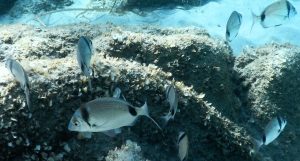IN A NUTSHELL
Author's Note
 As part of a series, a new article here building on the previous one which analyzed the ethical threshold of carbon emissions. The aim is to identify countries which may serve as references for sustainable use of natural resources, hence safeguarding intergenerational inequity and the wellbeing of coming generations as well as of other species.
The argument and conclusions challenge our anthropocentric nature
As part of a series, a new article here building on the previous one which analyzed the ethical threshold of carbon emissions. The aim is to identify countries which may serve as references for sustainable use of natural resources, hence safeguarding intergenerational inequity and the wellbeing of coming generations as well as of other species.
The argument and conclusions challenge our anthropocentric nature

By Juan Garay
Professor of Global Health Equity Ethics and Metrics in Spain (ENS), Mexico (UNAChiapas), and Cuba (ELAM, UCLV, and UNAH)
Co-founder of the Sustainable Health Equity movement
Valyter.es
Homo Interitans
Countries that Escape, So Far, the Human Bio-Suicidal Trend
This is the second article of a series aimed at measuring the global burden of health inequity[1]. It builds on the first one which analyzed the ethical threshold of carbon emissions[2], to expand the scope of ecological analysis. The aim is to identify countries which may serve as references for sustainable use of natural resources, hence safeguarding intergenerational inequity and the wellbeing of coming generations as well as of other species. The argument and conclusions challenge our anthropocentric nature.
If a visitor from another planet would analyze our existence as humans, it could reach the following conclusions:
“Among the 9 million life forms on the blue planet, humans are the dominant species. Their bodies consist of roughly 100 trillion cells and bacteria, and with about 20,000 genes, they produce over 100,000 types of proteins that sustain them for up to 100 revolutions around the star their planet orbits. Their brains contain approximately 100 billion neurons and 100 trillion synaptic connections. Humans have only existed for 0.04% of the planet’s lifespan, which they call “Earth” (though it’s more water than land). Since the last glaciation, 11,000 years ago, a period they term the “Holocene,” humans have flourished. They’ve eroded the land to select crops, settled in structures known as cities, and developed relationships with each other and nature, which they refer to as “civilization.” A common trait across almost all human societies is a belief in a higher force that created the universe and granted them dominion over other life forms. They organize themselves through power structures called hierarchies, with some claiming authority over. They use nature and its man-made transformations through the concept of “property,” laying claim to land, resources, and objects, leading to competition between individuals and groups. This drive to produce, possess, and consume is organized upon abstract monetary systems and intense speculation, which occupies a large share of human energy and relations. This system has resulted in the highly unequal share of wealth and resources, with just 1% of the population controlling over 50% of the planet’s land, assets, and money, the most skewed distribution of any variable on the planet. The unfair inequality, inequity influences all human variables, including their lifespan, with some living half the lifetime of those most privileged. Roughly 200 years ago, humans began burning fossilized remains of ancient life, setting off a cascade of environmental consequences. Their anthropocentric, hierarchical, and competitive nature has led to severe damage to the planet and all forms of life, including their own. The majority of the planet’s biomass is composed of just three elements: carbon (50%), oxygen (45%), and nitrogen (5%), out of the 118 elements present on Earth. Human activity has disrupted the balance of these elements across soil, biomass, water, and air. The burning of fossil fuels has dramatically increased CO2 levels in the atmosphere, triggering unprecedented global warming in the Holocene. Humans now extract nearly 300 trillion liters of oil from fossil deposits, which, when burned, will release 711 billion tons of CO2 into the atmosphere. However, the remaining CO2 that can be emitted without surpassing a 2°C rise in global temperatures—is only 1.1 billion tons. This temperature increase is akin to a fever, which, when sustained in human bodies, leads to self-destruction. Yet, despite this, humans continue to seek and extract more fossil fuels in a pattern that seems self-destructive. The harm humans inflict on the planet extends beyond fossil fuel consumption and greenhouse gas emissions. Their activities also lead to the depletion of freshwater and essential nutrients, causing soil dehydration, degradation, and contamination. Erosion, along with the excessive use of nitrogen and phosphorus in agriculture, has upset the balance of these elements in the soil, freshwater systems, and oceans, disrupting stable biomass dynamics. Although humans make up just 0.01% of the planet’s biomass, they have occupied two-thirds of the land and have caused the extinction of over 80% of what they term “wild” animals and so have driven one million species to the brink of extinction. In the meantime, they increased the population of species which they domesticated (“livestock”) a hundredfold. Each year, humans slaughter 78 billion land animals and 2.7 trillion fish. Power struggles between groups and “countries” (artificial divisions of land claimed by specific groups) have fueled the manipulation of basic elements into radioactive forms and developed nuclear weapons, capable of destroying all life on Earth several times over. Today, human interaction is largely mediated through screens (with an average of 2.5 hours of “connected” time per day), starting from early childhood. Information is increasingly shaped by algorithms known as “artificial intelligence,” controlled by a small elite linked to the above mentioned 1% power group. These algorithms influence relationships, consumption habits, and political choices, under the guise of “freedom.” Humans possess remarkable imagination and creativity, generating around 50,000 thoughts per day. They also have an inherent capacity for empathy and a deep connection between them, they call “love”, finding their greatest happiness in small, compassionate groups. However, their collective behavior leans more towards “homo interitans” (the destructive human) than their self-proclaimed “homo sapiens,” given their irrational, biocidal, and ultimately suicidal global dynamics.”
End of Alien Report
To better understand and measure how humans are distorting the balance of biological life with geological dynamics in our planet, William Rees and Mathi Wackernagel described in 1990 the ecological footprint metrics[3]. By defining the biocapacity and the human ecological footprint (through consumption and waste), we can estimate the stress we put on natural resources. Today the total biocapacity is estimated at 12,2 Bn hectares (1,5 Ha per person) while the human ecological footprint is in the range of 22 Bn hectares, meaning we would need almost two planets to serve our consumption and waste dynamics.
Johan Rockstrom described the planetary boundaries in 2009[4], setting limits to human activities, beyond which the environment may not be capable of recycling its levels and diversity of biomass in the way it has been balanced during the Holocene, allowing the flourishing of human civilization. Out of the nine planetary boundaries, humanity has trespassed 4 of them (climate, biodiversity, land use and P and N chemical flows), is close to trespass those of use if freshwater, ocean acidity and aerosol loading, and only remains in safe balance of ozone depletion.
The question is: Can human present levels and aspirations of improved wellbeing be compatible with the respect to other forms of life on our planet? The World Health Organization was set in 1947 aimed at working together so that all peoples could enjoy the best feasible levels of health[5]. That was long before we reflected, as Humanity, on the natural boundaries above mentioned.
The international agreements to reduce carbon emissions and respect biodiversity lack the goals to effectively reverse global warming and life depletion in our planet, and even so, compliance is even lower.
In order to set the best feasible levels of health, the only common global health goal, we need first (ecological feasibility/sustainability) to select the countries, regions and communities that respect those planetary boundaries. We use three indicators and thresholds to do so:
-CO2 emissions per capita and year below the ethical threshold (1,72 mT).
-Biocapacity per capita (ownership, national levels) below world average (1,5 Ha).
-Ecological footprint per capita below world average biocapacity per capita (1,5Ha).
As we only have data for national averages of the above indicators[6], we have selected the ecologically sustainable country-models based on the above-mentioned criteria. 109 countries have biocapacity pc below the world average, hence replicable in fair distribution of natural resources. 56 countries have ecological footprint pc below the world average biocapacity and therefore are replicable models to prevent progressive nature depletion. 72 countries have CO2 emissions below the ethical threshold mentioned above and do not contribute to global warming. 42 countries meet the three criteria. They are in sub-Saharan Africa (Benin, Burkina Faso, Burundi, Cameroon, Cape Verde, Ethiopia, Gambia, Ivory Coast, Kenya, Lesotho, Mali, Niger, Nigeria, Malawi, Rwanda, Senegal, Sierra Leone, Somalia, Sudan, Tanzania, Togo and Uganda), the Middle East (Jordan, Palestine, Syria and Yemen), Asia (Afghanistan, Bangladesh, Cambodia, Myanmar, Nepal, North Korea, Pakistan, Philippines, Sri Lanka and Tajikistan) and America (Haiti). The population living today in ecologically fair and sustainable countries is 872 million in sub-Saharan Africa, 729 in Asia, 67 in the Middle East and 10 in the Americas, adding up to 1,670,000 million, 21% of the world population. That share has decreased significantly (from 38%) after India increased in the last five years its CO2 emissions pc above the ethical threshold.
Country statistics lack precision and hid internal variations, yet they serve to estimate global figures, challenge current development paradigms (as the UN human development index, ranking best unsustainable country models by far) and trigger the study of sub-national territories and populations increasing the specificity of this much needed analysis and the sensitivity to find, including through qualitative research, relation, economic and political patterns respectful with nature.
In following articles, we will aim, from the countries with economically replicable models and the countries with levels of wellbeing above the world average, at identifying the sustainable-replicable-healthy models.
References
[1] https://www.sustainablehealthequity.org/concept-and-metrics
[2] https://www.peah.it/2024/07/13556/
[3] https://www.footprintnetwork.org/
[4] https://www.stockholmresilience.org/research/planetary-boundaries.html
[5] https://www.who.int/about/governance/constitution
[6] data from https://ourworldindata.org/
—
By the same Author on PEAH
Human Ethical Threshold of CO2 Emissions and Projected Life Lost by Excess Emissions
Restoring Broken Human Deal
Towards a WISE – Wellbeing in Sustainable Equity – New Paradigm for Humanity
A Renewed International Cooperation/Partnership Framework in the XXIst Century
COVID-19 IN THE CONTEXT OF GLOBAL HEALTH EQUITY
Global Health Inequity 1960-2020 Health and Climate Change: a Third World War with No Guns
Understanding, Measuring and Acting on Health Equity



